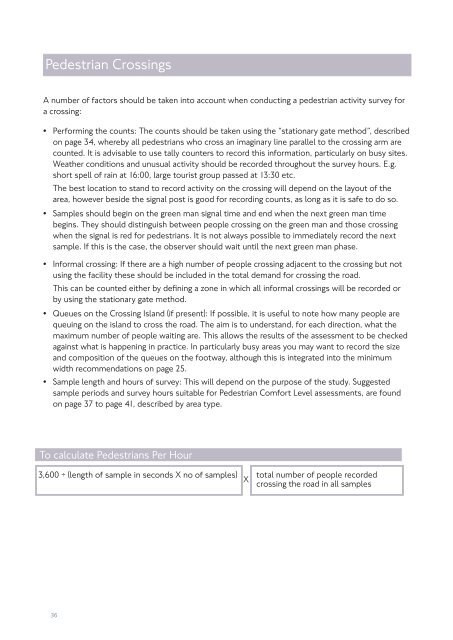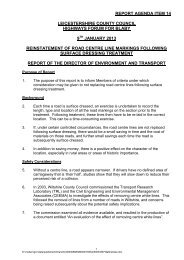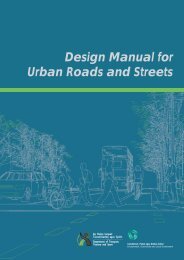Pedestrian Comfort Guidance for London
Pedestrian Comfort Guidance for London
Pedestrian Comfort Guidance for London
Create successful ePaper yourself
Turn your PDF publications into a flip-book with our unique Google optimized e-Paper software.
A number of factors should be taken into account when conducting a pedestrian activity survey <strong>for</strong><br />
a crossing:<br />
•<br />
•<br />
•<br />
•<br />
•<br />
<strong>Pedestrian</strong> Crossings<br />
Per<strong>for</strong>ming the counts: The counts should be taken using the “stationary gate method”, described<br />
on page 34, whereby all pedestrians who cross an imaginary line parallel to the crossing arm are<br />
counted. It is advisable to use tally counters to record this in<strong>for</strong>mation, particularly on busy sites.<br />
Weather conditions and unusual activity should be recorded throughout the survey hours. E.g.<br />
short spell of rain at 16:00, large tourist group passed at 13:30 etc.<br />
The best location to stand to record activity on the crossing will depend on the layout of the<br />
area, however beside the signal post is good <strong>for</strong> recording counts, as long as it is safe to do so.<br />
Samples should begin on the green man signal time and end when the next green man time<br />
begins. They should distinguish between people crossing on the green man and those crossing<br />
when the signal is red <strong>for</strong> pedestrians. It is not always possible to immediately record the next<br />
sample. If this is the case, the observer should wait until the next green man phase.<br />
In<strong>for</strong>mal crossing: If there are a high number of people crossing adjacent to the crossing but not<br />
using the facility these should be included in the total demand <strong>for</strong> crossing the road.<br />
This can be counted either by defining a zone in which all in<strong>for</strong>mal crossings will be recorded or<br />
by using the stationary gate method.<br />
Queues on the Crossing Island (if present): If possible, it is useful to note how many people are<br />
queuing on the island to cross the road. The aim is to understand, <strong>for</strong> each direction, what the<br />
maximum number of people waiting are. This allows the results of the assessment to be checked<br />
against what is happening in practice. In particularly busy areas you may want to record the size<br />
and composition of the queues on the footway, although this is integrated into the minimum<br />
width recommendations on page 25.<br />
Sample length and hours of survey: This will depend on the purpose of the study. Suggested<br />
sample periods and survey hours suitable <strong>for</strong> <strong>Pedestrian</strong> <strong>Com<strong>for</strong>t</strong> Level assessments, are found<br />
on page 37 to page 41, described by area type.<br />
To calculate <strong>Pedestrian</strong>s Per Hour<br />
3,600 ÷ (length of sample in seconds X no of samples)<br />
36<br />
X<br />
total number of people recorded<br />
crossing the road in all samples




